ELAC B5 Debut Series 5.25" Bookshelf Speakers by Andrew Jones
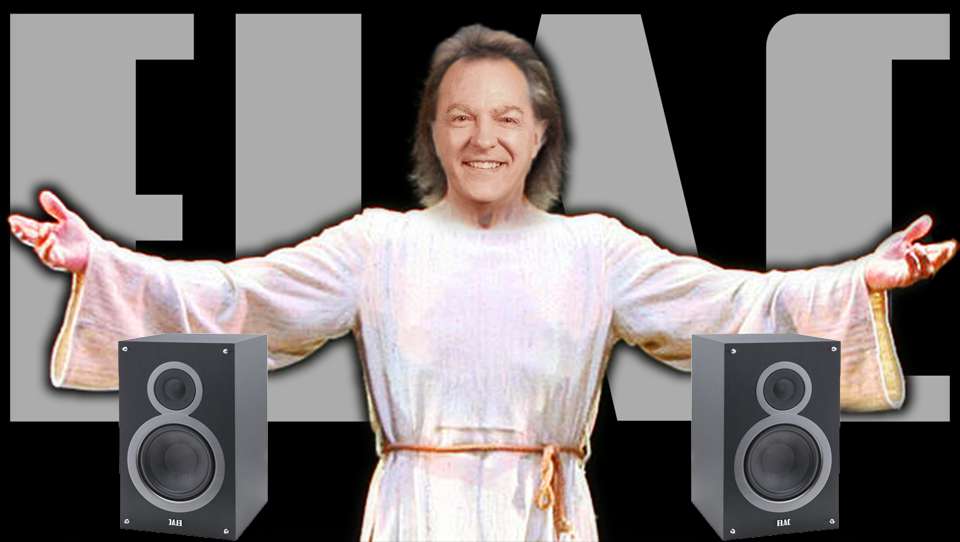
Andrew Jones, the messiah of budget audio. He will deliver us from the old testament hell of bad speakers to the promised land of ELAC America.
One of my favorite people in the industry, Andrew Jones, who is rumored to be both a doctor, as well as knighted by at least one of the crowns of Europe has switched teams.
Jones is jumping ship from Pioneer after it attempted to sell him into indentured servitude in a merger with Onkyo, and is now batting for the Germans at ELAC America.
In a strange intellectual property situation Jones has been able to keep his name, but his signature is forever property of Pioneer electronics.
Other than that the transition appears to be going smoothly with a full line of entry level speakers from ELAC hitting the market just months after Jones got started.
This ELAC B5 speaker I'm reviewing is the lowest price bookshelf speaker of the group known as the debut series.
Grill:
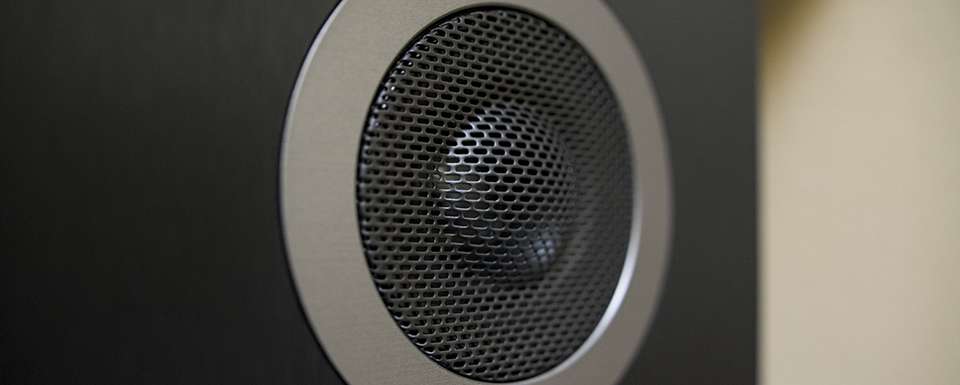
As with all Andrew Jones speakers, we start with the grill... Jones loves the grills, but they don't love him back.
On this latest series of speakers we have multiple layers of grill to make sure that all high frequency information is completely smothered in cloth, plastic, metal and some type of what I can only assume to be powder coating.
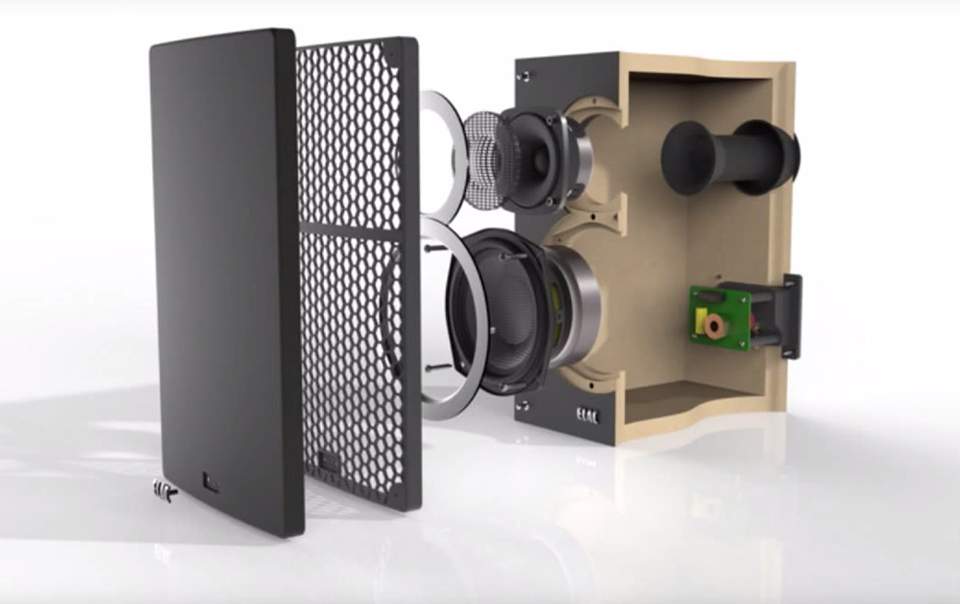
The explanation for all of this protection is these speakers are supposedly going to be in a showroom somewhere, and an idiot will try to touch the "magic sound buttons" ruining the speakers. Well, as far as I can tell the Debut Series are only going out through Amazon and being preordered direct from ELAC, so all the grilling seems much ado about nothing.
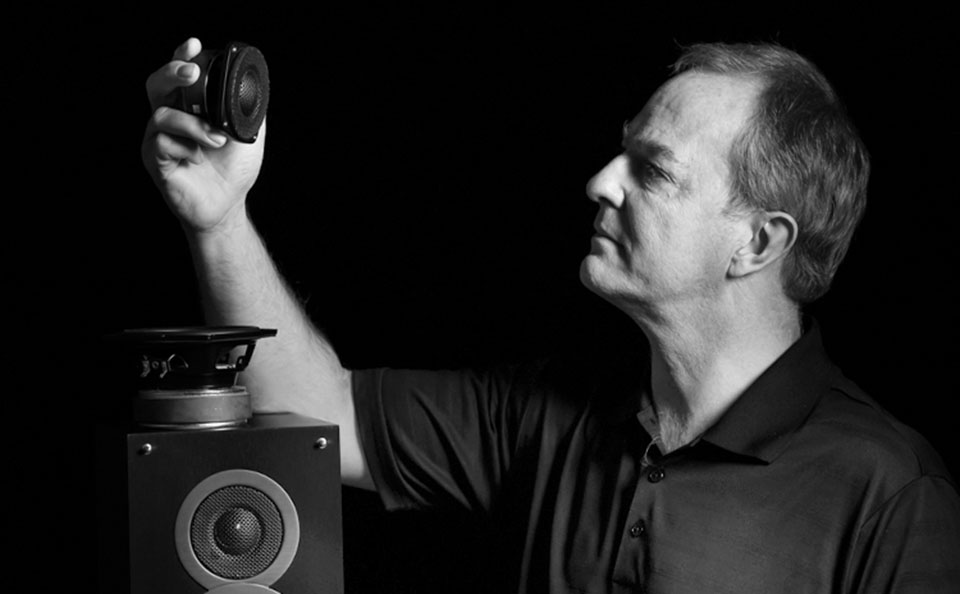
"Dome tweeters are so fragile and yet so powerful" - Sir. Andrew Jones
Tweeter:
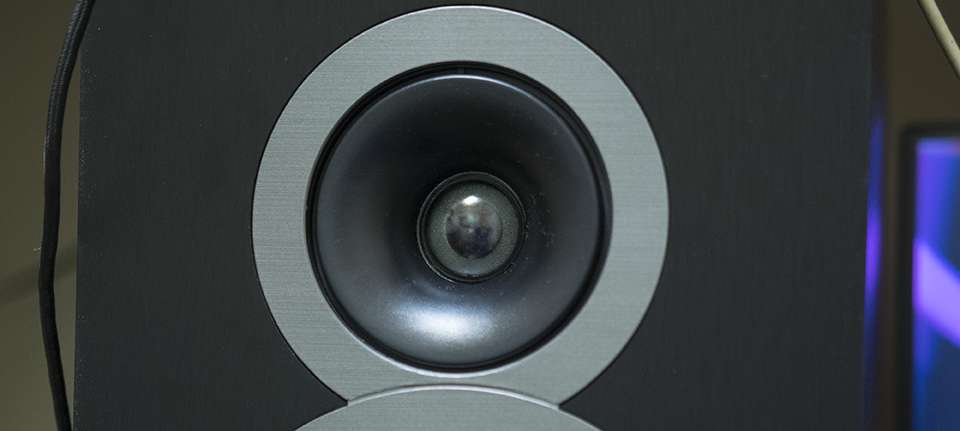
Paper clip folding and light prying got the grill off the tweeters with only minimal effort. Without the grills the speaker is very elegant, but the tweeter driver, thanks to the horn loading and slimy coating, looks like a creepy dead eye from a fish that's been out in the sun too long.
Woofer:
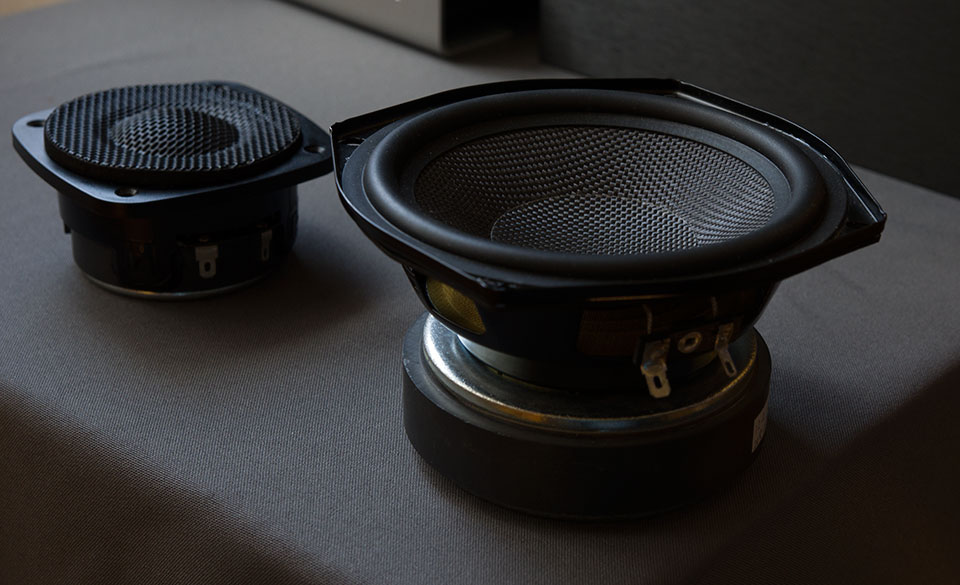
Dr. Jones keeps telling people that this is some kind of aramid fiber, which I think is a paper made from rare New Zealand bird pelts.
I'm not sure what he is on about, the cone looks like carbon fiber to me. One thing I know for sure is that the inverted dust cap was specifically inverted to avoid touchy-touchy people denting the cones.
I think it's retarded, and you can't convince me that it wouldn't sound better with a standard dust cap.
Other useful specifications about the woofer are that it uses a big voice coil, inch and one half from what I recall.
This is to help with power handling and venting as there is a larger than average hole for the space behind the dust cap to vent to the cabinet as the cone flaps around.
The driver looks pretty nice, and I think outside of the dust cap it's very good reminding me of something I would see from a company like Morel.
Crossover:
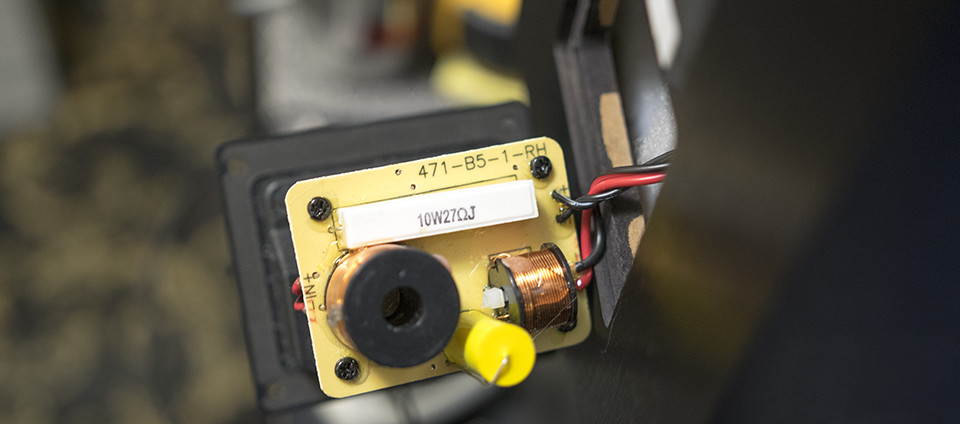
Here is the crossover for the speaker. According to the documentation on the side of the box it's supposed to crossover the drivers at 3,000Hz.
Take note of the cabinet construction, it's not very thick and has the same Chinese cardboard texture found in only the cheapest MDF. Also, there are no braces inside of the box. knuckle wrap sounds alright with the thick vinyl coating on the outside doing some damping.
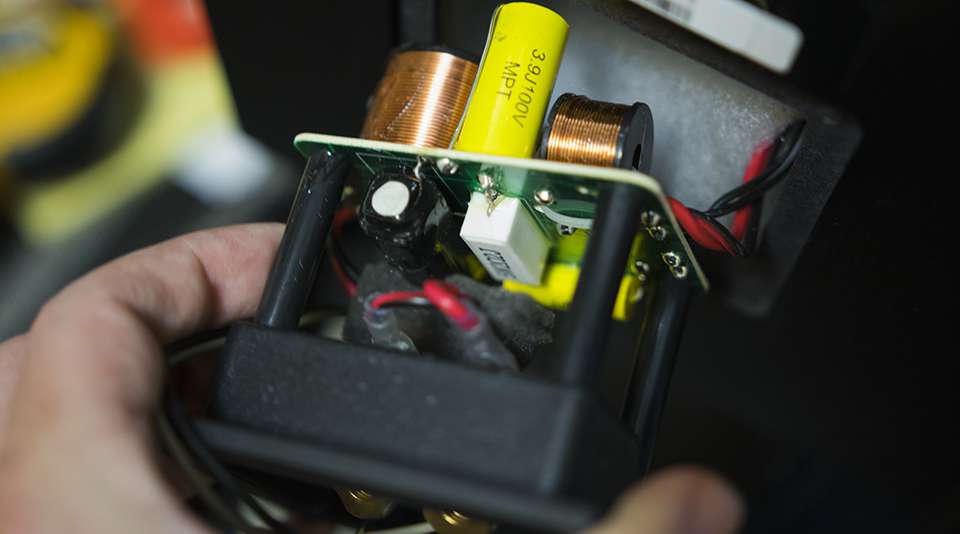
The crossover has one iron core inductor, two air core, and a pair of poly caps and a pair of wire wound resistors. If I had to guess I would say this is a 2nd order crossover with some baffle step and level matching of the tweeter.
Port:
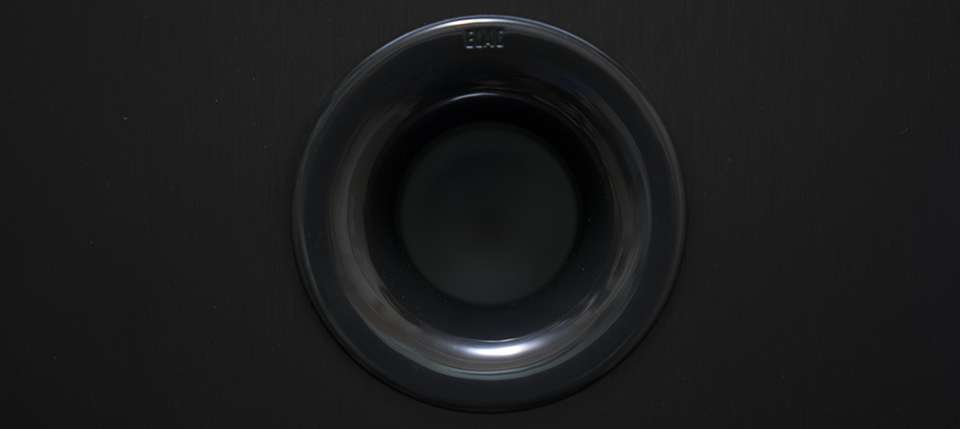
Branded port, you know these guys mean business. This port looks okay, and sits on the back of the speaker. Also, look at that textured vinyl coating on the speaker, this texture looks sharp and feel sleek as well.
Terminals:

The B5's terminals are probably the nicest of any speaker I've owned. I shit you not. The terminal is flush mounted, and these binding posts are sculpted like nothing I've seen before. Problem is they don't actually make it very easy to tighten down the connection, but they work out just fine if you fiddle enough. Check out the 18AWG wire, I'm going all out with the budget theme.
Living room Setup:

The B5's are happy to sit on top of my subwoofers, which will be only operating as stands for listening.
Instead of pulling my whole system apart to test the ELAC B5's, I grabbed a real budget amp the SMSL SA-50 and my phone as a source and made a quick hook up to see how cheap you can go to get good sound.
Well, the SA-50 could not cut it. The resulting sound was less than good when I tried to get even a little bit loud. I think the 4 ohm load and my expectations were just too much for the little amp.
I swapped in an old Kinergetics Class-A amp which is good for 150wpc into 4 ohms, and things improved dramatically.
While it's not entirely realistic to assume purchasers of these budget speakers will have quality amps laying around, I think the SA-50 just did not have enough grunt to it.
Cheap class D amps are notorious for overrating their power, so while it says 50wpc on the box it's probably done by 20 watts... which is plenty for many situations, it's just not enough to test the limits of the ELAC B5.
The 2 channel integrated amp ELAC plans to sell alongside the Debut Series speakers is a 100wpc BASH amp that will probably do the job just fine.
Living room impressions
One thing I noticed when going through the photos from shows is that these speakers are never presented on axis to the public.
They are always on stands that are too short, the tweeter on the floor stander is less than 3 feet high. I've got the B5's on stands putting the speakers about an inch taller than that of the floor stander, so it should be close to
recommended.
If I bend down to listen on axis things get odd - it seems as though the direct sound has no relation to the sound you hear anywhere else in the room.
The placement here is not very close to the rear wall, but the bass response was a little overwhelming to the rest of the music.
The room sound is even coverage of thick bass and lower midrange, with the upper midrange/lower treble almost absent, but a sparkle in the treble makes it sound a little more balanced.
In contrast the on axis sound is maybe flat, it's hard to tell, it's a sea change from the other 95% of the room. I'd love to see the polar response of this speaker, it's got some strange things going on.
I end up trying both with and without the tweeter grill, and preferred the tweeter grill on when sitting in the listening position.
After attempting to dissect the sound I settled in to my normal listening position and gave a few tracks a good relaxed listen. Imaging is great, realistically sized performers, even with the speaker being low I can hear the performers singing from a standing position. Nice wide sweet spot, very comfortable as you don't feel locked into one position.
The upper midrange/low treble response is recessed which gives an overly smooth sound, but also makes it hard to hear some of the performance as it gets smothered in bass. Bass response is very clean up and even to the point where it's either missing or not getting any louder.
The B5 speakers do not get loud... they just don't put out enough sound in 4k-8k range to trigger that sensation of loud. I pulled out the SPL meter and was putting out 97dB of music on the couch and it felt more like a small breeze instead of the hurricane of sound I would normally get at 97dB.
Bend over slightly and there is a blasting sensation as you enter the on axis zone at volume. These speakers are very odd.
The woofers seem to be more than happy to try and over extend while attempting to play deep bass. Not sure there is enough of an air spring to keep these things alive in a party situation, it would probably be a good idea to have a sub sonic filter on these speakers if you are not going to cross them over to a subwoofer.
Desktop Setup:
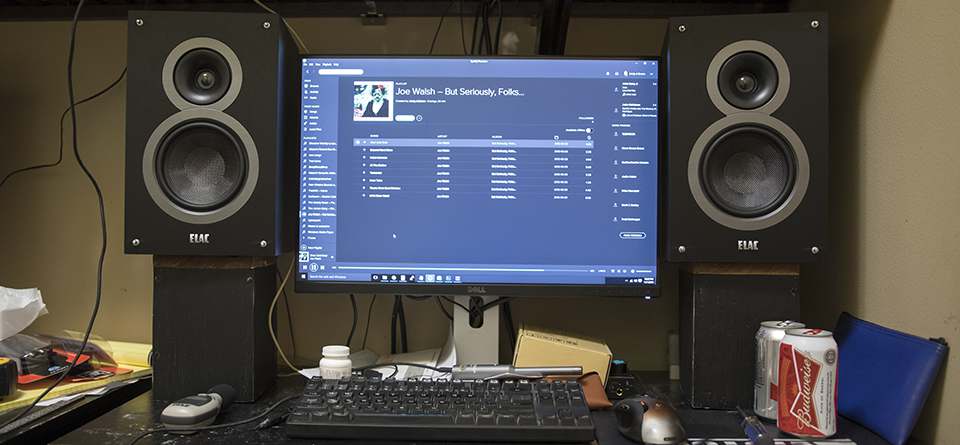
For desktop testing and measuring I set the speakers up in my office running off of my used Onkyo home theater receiver, a HT-R520 which is fed by my computer via a toslink optical connection.
This is a true near field setup, where I can touch both speakers at the same time with my finger tips.
Desktop impressions:
In the horizontal axis of the speaker, but listening with almost no toe in from arms length away is a completely different sound. While this may seem redundant to say, usually with speakers you get only the direct sound and variations of bad placement. Here it seems you get two speakers for the price of one.
Initially I listened for a few hours with the tweeter grills in place and things sounded bad. This is not as big a deal when the speakers are further way, but this close the grills were a big problem.
After removing the grills I immediately hear the waveguide doing what it's supposed to do, projecting the sound out. This tweeter is light years ahead of the ones on the Pioneer BS-22.
In contrast to the roasted marshmallow sound of the living room, the ELAC B5 speakers sound pretty damn flat now. The bass below 80Hz sounds rolled off, but they play down to 50Hz fairly well although it's not really "there" unless you crank on the volume a good bit.
Treble is good, but forward. No problems hearing things now, it's all there. Also they get fucking loud from this position - 110dB is there if you want it.
I can hear something coming from the woofer that is strange. It's something in the fundamental frequency range, it's too low for cone break up on a speaker this size, but too high to much else.
I couldn't put my finger on it, and I let it bother me trying to find a song that exemplified the error, but after a couple of hours of listening really hard I have yet to find anything that really nails the issue down.
Here is my best guess of what I'm hearing -- it's the treble response of the woofer, this is where the inverted dust cap decision comes calling.
The dispersion of the lower treble the woofer is being asked to do with the somewhat high crossover point for the driver spacing and 2nd order slope the treble is bouncing around the woofer cone in a way that is unfamiliar to me.
Now I've got an answer to my question I can get back to enjoyable listening, and the speakers are sounding very good.
Let's take some measurements:
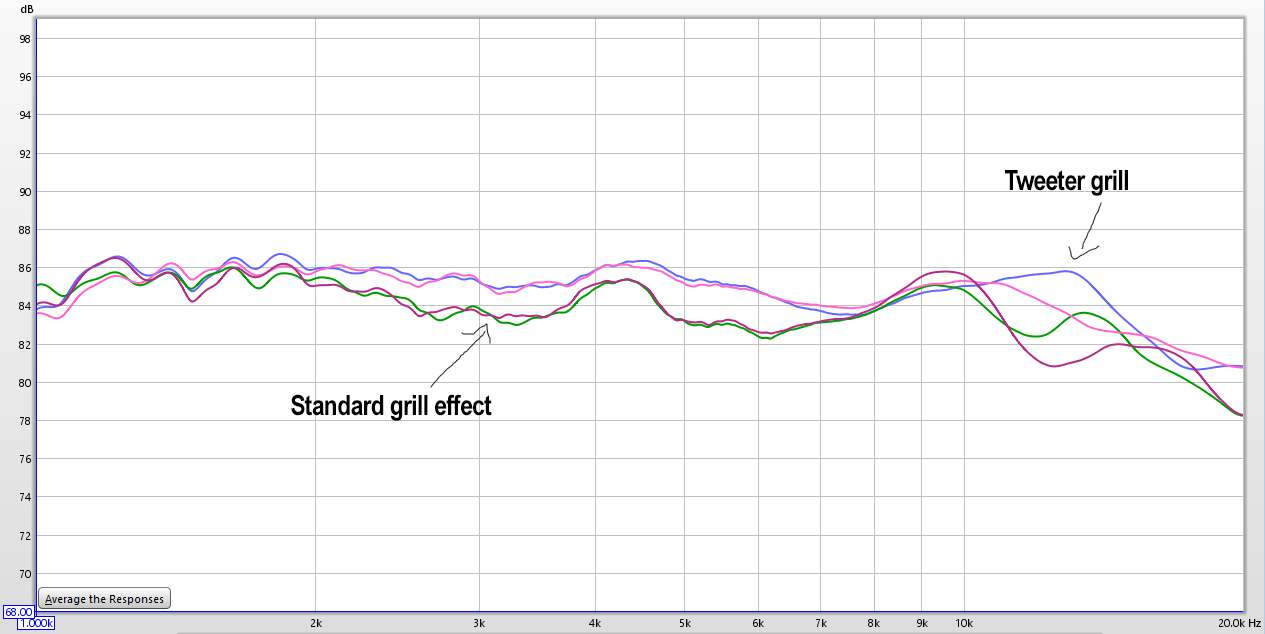
The blue line is a measurement of the naked speaker, red being a completely covered speaker, with the other two measurements being variations of covered.
Note the top octave is all hosed up from the extreme horn loading on the dome tweeter.
The standard grill giving a full body 1-2dB smother from 2k on up, and the tweeter grill is limited to about 11k on up.. but I found subjectively it messed with the sound a lot more than is indicated in this graph.
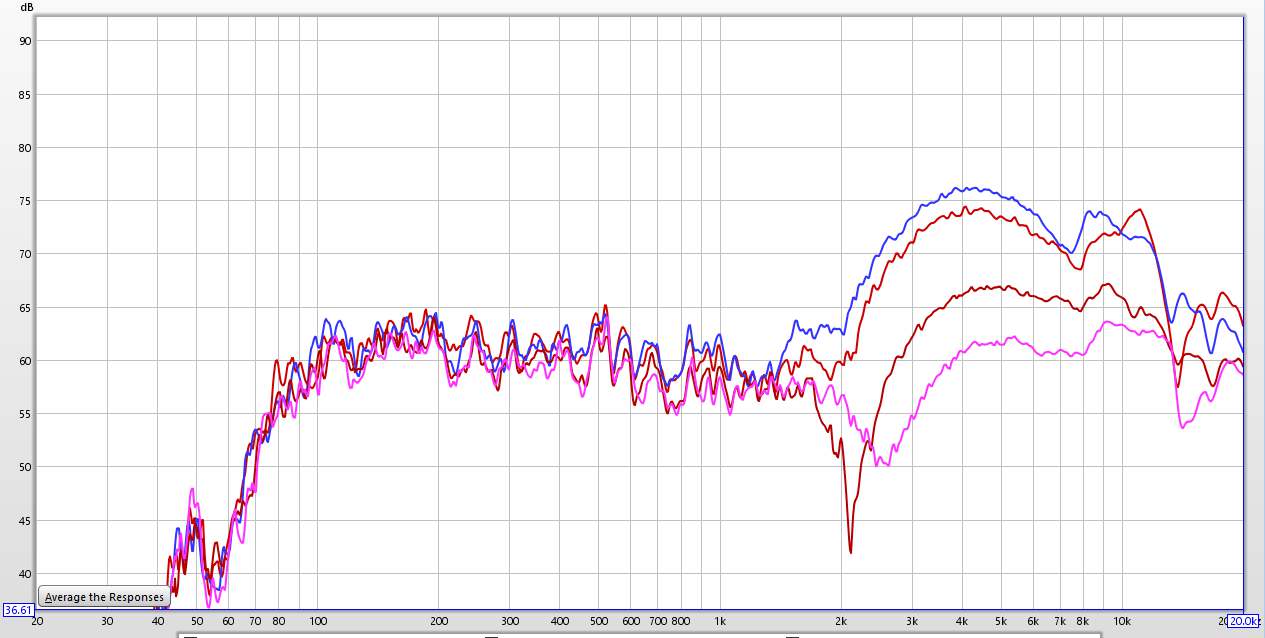
Close mic measurements of the tweeter show the horn flare up starts around 8k(1.7 inches), which if I had to guess is the distance from the voice coil to the edge of the waveguide. This is noticeable with near field listening, and will bother some people. Upper octave response on all of the measurements really takes a dive after 13k. This is just barely noticeable near field, and not at all a thing to be concerned with in a living room setting.
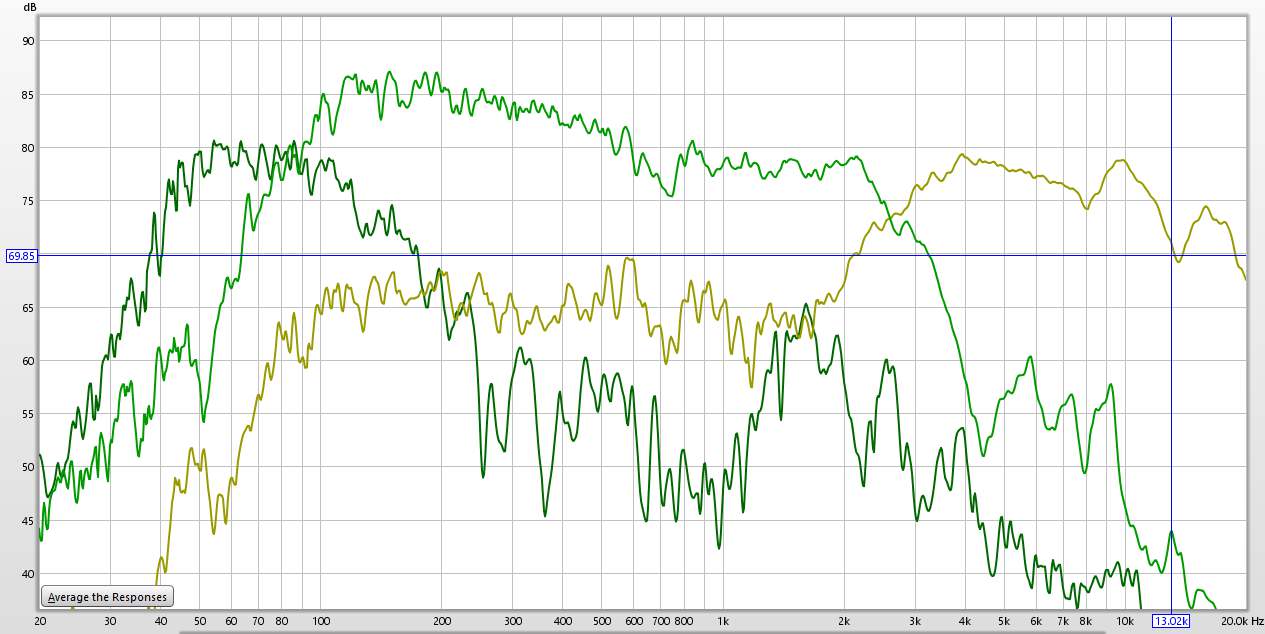
Close driver measurements with a RTA shows a little bit of port leakage centered around 1k, but it's 15dB below the port output and plugging the port did not show any changes in the on axis midrange response.
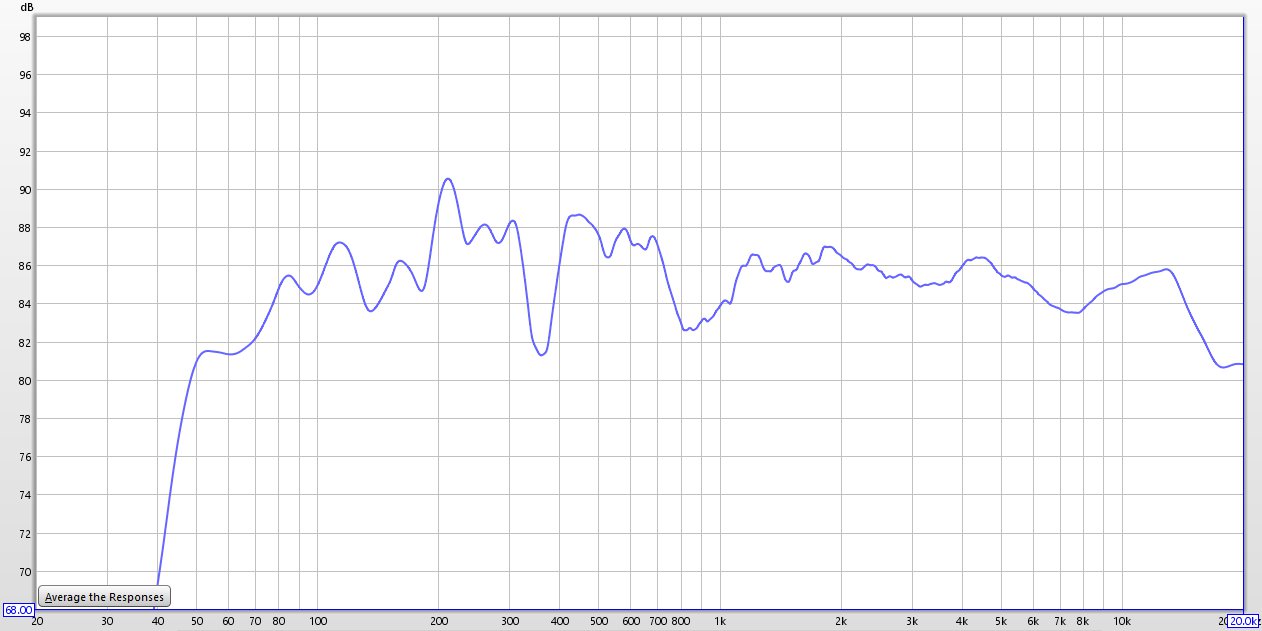
This response looks very good, +-2dB for all of the important parts I can measure reliably(700Hz and up). The dip centered at 900Hz appears to be a reflection from the stand I had the speaker on because it does not show up in other measurements including the close driver results as seen above. Below 700Hz we can see the mess my room makes of the speaker, but it does give us an idea of the bass extention. We can see here it's comfortably down the 50Hz, while the close driver measurement of the port above shows it putting out good bass to 40Hz.
DSP Correction:
The speaker has quirks, but nothing is directly correctable via DSP. We are talking about horn effect that reaches into the audible territory, crossover point being a little high for the driver spacing, and dispersion of the woofer not dispersing enough. Going and dicking with the frequency response is not going to fix any of these fundamental conditions.
Final thoughts:
The ELAC B5 speakers perform in a living room setting. While they don't do everything by the book they play music in an engaging, entertaining, none offensive way.
Not only do the B5's do the job, they do more than is expected and play low enough cleanly that a subwoofer is truly optional.
That being said, the B5 speakers work on a desktop, but it's not as clear cut a win. While these are better than many small speakers, they are just too big for most desktop setups.
Not only that, the quirks of the speaker mostly show up in the near field.
I would say that the B5 is a recomendation if this is going into a shared use space like dorm or bedroom where the speakers will be used for more than close monitoring computer audio.
Click here to buy the ELAC B5 speakers.
Check out the system finder to see what I recommend.
Other content you may like:
- Vanatoo Transparent One Review - Software update brings new standard of performance!
- Lone Star Audio Fest 2018 - Staying up late, drinking too much, smoking like chimneys!
- Andrew Jones goes back the be begining, ELAC B5.2 Debut 2.0 Review is up!
- New Scores for all reviewed speakers - Compare and sort for fun!
- Creative Sound Solutions DIY Solution for the high end - CSS Criton 1TD v2 review is up!
- Dayton Makes a Budget Desktop speaker with a crossover - Dayton Audio MK402 review is up!
- Smaller than small, deeper than deep - iLoud Micro Monitor review is up!
- Vanatoo's new speaker, The Transparent Zero review is up!
- SVS Prime Bookshelf Review is now available for your viewing pleasure
- ELAC A-Stock UB5 Listening Impressions are up!
- 30 years in the making, the ancient Bose 901 finally gets measured - The Bose 901 review is up!
- Lock and load, we are hitting the bottom of the barrel with both barrels - The Logitech z313 review is up!
- Bulletproof speakers... No, it's just the B&W 686 S2 Review!
- Declare independence from the British sound! - The KEF Q300 review is up!
- Recommended System Finder - Just in time for the Holidays!
- JBL LSR308 Studio Montor - Super Massive Epic Review!
- Two years after starting this site I finally get around to talking about my stereo.
- Small and cheap speakers transform into retarded and good... Micca COVO-S Review!
- AMT tweeter on a B652? The Dayton B652-AIR is reviewed for great justice!
- JBL LSR305 Studio Monitor Review!
- Zu Essence Review!

